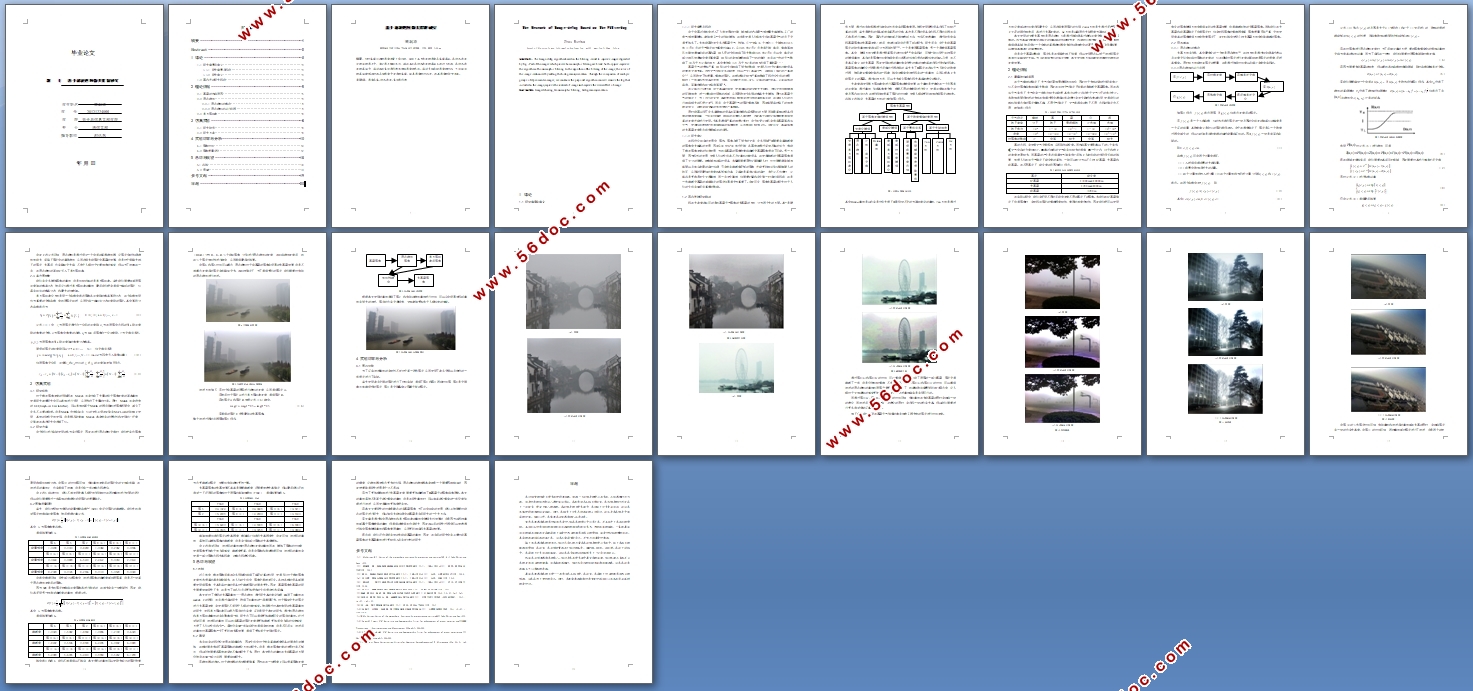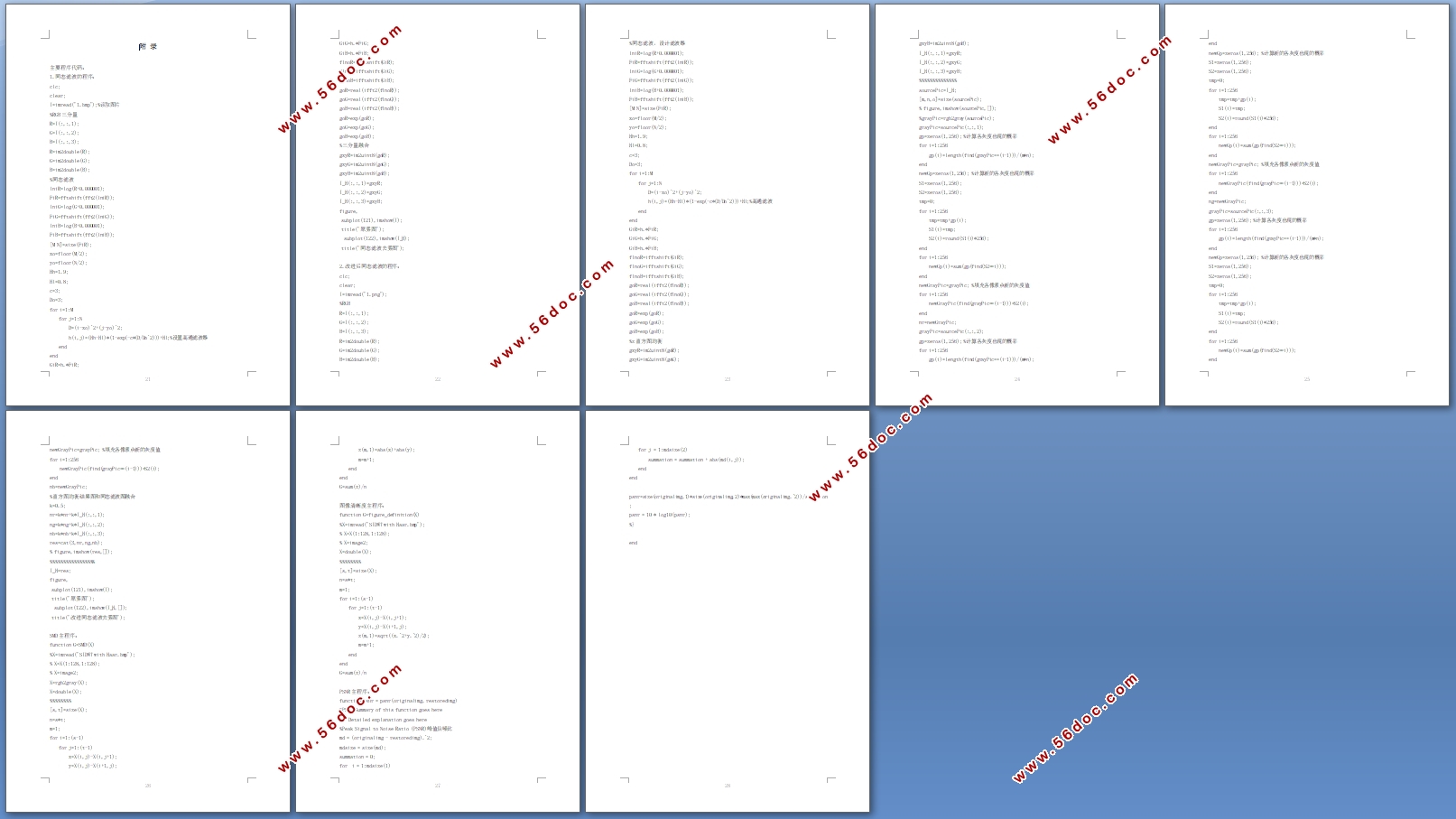基于滤波的图像去雾霾研究
来源:56doc.com 资料编号:5D27847 资料等级:★★★★★ %E8%B5%84%E6%96%99%E7%BC%96%E5%8F%B7%EF%BC%9A5D27847
资料以网页介绍的为准,下载后不会有水印.资料仅供学习参考之用. 密 保 惠 帮助
资料介绍
基于滤波的图像去雾霾研究(论文10000字,外文翻译,主要代码)
摘要:针对雾霾引起的图像质量下降问题,提出了基于滤波的图像去雾霾算法。在同态滤波处理后的图片中,部分图片黯淡无光,因此本文在同态滤波的算法上进行了改进。在同态滤波的算法中,通过添加直方图均衡来增强图像的色彩。通过多组实验图像的对比,可知提出的算法能够很好地去除图像中含有的雾霾,提高图像的对比度,改善图像的视觉效果。
关键词:图像去雾,同态滤波,直方图均衡
The Reseach of Image-defog Based on The Filtering
Abstract: The Image-defog algorithm based on the filtering is used to improve images degraded by fog . Part of the images which process homomorphic filtering are bleak. So this paper improves the algorithm of homomorphic filtering. In the algorithm of the filtering of the image, the color of the image is enhanced by adding the histogram equalization. Through the comparison of multiple groups of experimental images, we can know the proposed algorithm can well remove the fog that included in the image,improve the contrast of image and improve the visual effect of image.
Key words:Image dehazing; Homomorphic filtering; Histogram equalization



目 录
摘要•••••••••••••••••••••••••••••••••••••••••••••••••••••••1
Abstract•••••••••••••••••••••••••••••••••••••••••••••••••••2
1 绪论•••••••••••••••••••••••••••••••••••••••••••••••••••••3
1.1 研究背景及意义•••••••••••••••••••••••••••••••••••••••••••••••••••••••••3
1.1.1 研究背景及现状•••••••••••••••••••••••••••••••••••••••••••••••••••3
1.1.2 研究意义•••••••••••••••••••••••••••••••••••••••••••••••••••••••••3
1.2 国内外的研究现状•••••••••••••••••••••••••••••••••••••••••••••••••••••••3
2 理论依据•••••••••••••••••••••••••••••••••••••••••••••••••5
2.1 雾霾的形成原因•••••••••••••••••••••••••••••••••••••••••••••••••••••••••5
2.2 同态滤波•••••••••••••••••••••••••••••••••••••••••••••••••••••••••••••••6
2.2.1 同态滤波的概念•••••••••••••••••••••••••••••••••••••••••••••6
2.2.2 同态滤波的运行流程•••••••••••••••••••••••••••••••••••••••••••••••6
2.3 直方图均衡•••••••••••••••••••••••••••••••••••••••••••••••••••••••••••••8
3 仿真实验•••••••••••••••••••••••••••••••••••••••••••••••••8
3.1 研究软件•••••••••••••••••••••••••••••••••••••••••••••••••••••••••••••••8
3.2 研究方案•••••••••••••••••••••••••••••••••••••••••••••••••••••••••••••••8
4 实验结果与分析••••••••••••••••••••••••••••••••••••••••••10
4.1图像对比••••••••••••••••••••••••••••••••••••••••••••••••••••••••••••••10
4.2图像质量评价•••••••••••••••••••••••••••••••••••••••••••••••••••••••••••17
5 总结与展望••••••••••••••••••••••••••••••••••••••••••••••18
5.1总结•••••••••••••••••••••••••••••••••••••••••••••••••••••••••••••••••••18
5.2 展望••••••••••••••••••••••••••••••••••••••••••••••••••••••••••••••••••19
参考文献••••••••••••••••••••••••••••••••••••••••••••••••••19
致谢••••••••••••••••••••••••••••••••••••••••••••••••••••••20
|







